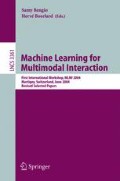Abstract
People are emotional, and machines are not. That constrains their communication, and defines a key challenge for the information sciences. Different groups have addressed it from different angles, trying to develop methods of detecting emotion, agents that convey emotion, systems that predict behaviour in emotional circumstances, and so on. Progress has been limited. The new network of excellence HUMAINE explores the idea that progress depends on addressing the problem as a whole, not in isolated fragments.
Access this chapter
Tax calculation will be finalised at checkout
Purchases are for personal use only
Preview
Unable to display preview. Download preview PDF.
References
Picard, R.W.: Affective Computing. MIT Press, Cambridge (1997)
HUMAINE portal, http://emotion-research.net/
Russell, J., Barrett-Feldman, L.: Core affect, prototypical emotional episodes, and other things called emotion: Dissecting the elephant. J. Pers & Soc Psychol 76, 805–819 (1999)
Cowie, R., Douglas-Cowie, E., Tsapatsoulis, N., Votsis, G., Kollias, S., Fellenz, W., Taylor, J.: Emotion recognition in human-computer interaction. IEEE Sig. Proc. Magaz. 18, 32–80 (2001)
Cowie, R., Cornelius, R.: Describing the Emotional States that are Expressed in Speech. Speech Comm. 40, 5–32 (2003)
Scherer, K., et al.: HUMAINE Deliverable D3c: Preliminary plans for exemplars: theory, http://emotion-research.net/
Ekman, P.: Basic emotions. In: Dalgleish, T., Power, M.J. (eds.) Handbook of Cognition & Emotion, pp. 301–320. John Wiley, New York (1999)
Douglas-Cowie, E., Campbell, N., Cowie, R., Roach, P.: Emotional Speech: towards a new generation of databases. Speech Comm. 40, 33–60 (2003)
Kwon, O., Chan, K., Hao, J., Lee, T.-W.: Emotion recognition by speech signals. In: Proc. Eurospeech, pp. 125–128 (2003)
Batliner, A., Fischer, K., Huber, R., Spilker, J., Nöth, E.: How to find trouble in communication. Speech Comm. 40, 117–143 (2003)
Ang, J., Dhillon, R., Krupski, A., Shriberg, E., Stolcke, A.: Prosody-based automatic detection of annoyance and frustration in human-computer dialog. In: Proc. ICSLP, Denver, Colorado (2002)
Hadfield, P., Marks, P.: This is your captain dozing. New Scientist, 1682267, 21 (2000)
McMahon, E., Cowie, R., Kasderidis, S., Taylor, J., Kollias, S.: What Chance that a DC Could Recognise Hazardous Mental States from Sensor Outputs? In: Tales of the Disappearing Computer, Santorini (2003)
Zhou, G., Hansen, J.H., Kaiser, J.F.: Methods for stress classification: Nonlinear TEO and linear speech based features. In: Proc. IEEE Int Conf on Acoustics, Speech, Signal Processing, vol. IV, pp. 2087–2090 (1999)
Haddad, D., Ratley, R., Walter, S., Smith, M.: Investigation and Evaluation of Voice Stress Analysis Technology. Final Report US Dept of Justice Report NCJ Number 193832 (2002)
ERMIS team D03: System Architecture and Testbed Specifications ERMIS project IST-2000-29319 (2002)
Aizawa, K.: Position Statement. In: Proc. VLBV 2001, Athens, vol. 3 (2001)
Höök, K., Sengers, P., Andersson, G.: Sense and Sensibility: Evaluation and Interactive Art Computer Human Interaction, Fort Lauderdale (2003)
Paiva, A. (ed.): Affective Interactions: Towards a New Generation of Computer Interfaces. Springer, Berlin (2000)
Yacoub, S., Simske, S., Lin, X., Burns, J.: Recognition of emotions in interactive voice response systems. In: Proc. Eurospeech, Geneva (2003)
Cowie, R., McGuiggan, A., McMahon, E., Douglas-Cowie, E.: Speech in the Process of Becoming Bored. In: Proc. 15th ICPhS, Barcelona (2003)
Gross, J.J., Levenson, R.W.: Emotion elicitation using films. Cognition and Emotion 9, 87–108 (1995)
Picard, R.W., Vyzas, E., Healey, J.: Toward Machine Emotional Intelligence: Analysis of Affective Physiological State. IEEE Trans Patt Analysis & Machine Intell 23, 1175–1191 (2001)
Stemmler, G., Heldmann, M., Pauls, C., Scherer, T.: Constraints for emotion specificity in fear and anger: the context counts. Psychophysiology 69, 275–291 (2001)
Parkinson, B.: Ideas and realities of emotion, Routledge, New York (1995)
James, W.: What is emotion? Mind 9, 188–205 (1884)
Cannon, W.B.: Against the James-Lange theory of emotion. Psych Rev. 38, 106–124 (1931)
Cornelius, R.: The Science of Emotion: Research and tradition in the psychology of emotion. Prentice-Hall, Upper Saddle River (1996)
Wundt, W.: Grundzuge der Physiologischen Psychologie, vol. 2. Engelmann, Leipzig (1903) (Original published 1874)
Schlosberg, H.: A scale for judgment of facial expressions. Journal of Experimental Psychology 29, 497–510 (1954)
Watson, D., Tellegen, A.: Toward a consensual structure of mood. Psych Bull 98, 219–235 (1985)
Ortony, A., Clore, G., Collins, A.: The cognitive structure of emotions, CUP, Cambridge, England (1988)
Schröder, M.: Speech and Emotion Research: An overview of research frameworks and a dimensional approach to emotional speech synthesis. PhD thesis, PHONUS 7, Research Report of the Institute of Phonetics, Saarland University (2004)
Stibbard, R.: Vocal expression of emotions in non-laboratory speech. PhD thesis, University of Reading (2001)
Cummings, K., Clements, M.: Analysis of glottal excitation of emotionally styled and stressed speech. JASA 98, 88–98 (1995)
Williams, C.E., Stevens, K.N.: Emotions and speech: Some acoustical correlates. JASA 52, 1238–1250 (1972)
Cowie, R., Douglas-Cowie, E., Cox, C., Cemegil, A.T.: D09:Final Version Of Non-Verbal Speech Parameter Extraction Module ERMIS project IST-2000-29319 (2004)
Ladd, D.R., Silverman, K., Tolkmitt, F., Bergmann, G., Scherer, K.: Evidence for the independent function of intonation contour type, voice quality, and F0 range in signaling speaker affect. JASA 78, 435–444 (1985)
Mozziconacci, S.: Speech variability & emotion: Production & perception. Ph. D. thesis, Technical University Eindhoven (1998)
Trappl, R., Petta, P., Payr, S. (eds.): Emotions in Humans and Artifacts, The MIT Press, Cambridge (2003)
Author information
Authors and Affiliations
Editor information
Editors and Affiliations
Rights and permissions
Copyright information
© 2005 Springer-Verlag Berlin Heidelberg
About this paper
Cite this paper
Cowie, R., Schröder, M. (2005). Piecing Together the Emotion Jigsaw. In: Bengio, S., Bourlard, H. (eds) Machine Learning for Multimodal Interaction. MLMI 2004. Lecture Notes in Computer Science, vol 3361. Springer, Berlin, Heidelberg. https://doi.org/10.1007/978-3-540-30568-2_26
Download citation
DOI: https://doi.org/10.1007/978-3-540-30568-2_26
Publisher Name: Springer, Berlin, Heidelberg
Print ISBN: 978-3-540-24509-4
Online ISBN: 978-3-540-30568-2
eBook Packages: Computer ScienceComputer Science (R0)

